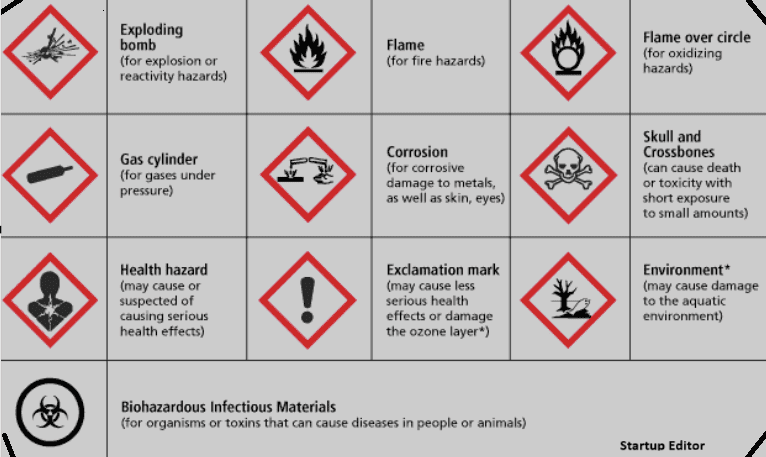For all workers in Canada, safety at work is a priority. It does not matter if you are in a factory, a hospital, a laboratory, or a construction site; you must learn the proper way to deal with dangerous materials. One of the safest ways to achieve this is to get familiar with the WHMIS symbols.
These symbols are used on the labels of various products, such as cleaning and chemical ones, as well as on the containers of the products. They indicate the extent of harm a product can cause – for instance, whether it is highly flammable, very toxic, or can cause severe burns. Knowing them means a higher level of protection at work for you and your colleagues.
The following guide presents the meaning of WHMIS symbols, how to interpret WHMIS pictograms, and also the need of having a WHMIS certificate if you are dealing with hazardous products in Canada.
What Are WHMIS Symbols?
The WHMIS symbols—or pictograms—are just small images that indicate, through labelling, what kind of danger a product can cause. They are one of the integral aspects of the Canadian Workplace Hazardous Materials Information System (WHMIS). WHMIS is the way through which employees can very easily identify hazards and acquire an understanding of them.
The world at large recognizes GHS as the standard system; Canada is no exception. Therefore, WHMIS symbols are in line with those of GHS, making them easier to understand. If you’re already familiar with WHMIS in Canada, you’ll have no problem interpreting safety symbols almost anywhere else in the world.
Why WHMIS Symbols Matter
When workers use the right WHMIS symbols, chemical accidents rarely happen. These symbols warn them before they handle dangerous products. By recognizing the symbols, workers can take safety steps like wearing gloves, goggles, and face masks.
Take the following as an example:
- The Flame symbol signifies highly combustible material.
- The Corrosion symbol indicates the product involved has the capability of damaging not only skin but also metals.
- The Skull and Crossbones symbol denotes that the material is toxic.
It leads to a safer working environment when all workers comprehend the signs. Employers must train workers to recognize WHMIS symbols and understand their meanings.The training creates a workplace that is less prone to injuries and health issues.
Types of WHMIS Symbols
Here are the most common WHMIS symbols in use throughout Canada:
Flame – The product is flammable and can ignite with the slightest spark.
Flame Over Circle – It means the substance is a strong oxidizer and thus readily supports combustion.
Gas Cylinder – The material is a gas under pressure.
Corrosion – This product has the capability of causing burns to human skin or damaging metals.
Exploding Bomb – The broad category of such materials can explode; therefore, avoiding heating or mishandling is imperative.
Skull and Crossbones – This substance is poisonous or fatal if swallowed or inhaled.
Health Hazard – The hazard posed by this material to health is severe and may include causes of cancer or organ damage.
Exclamation Mark – Users may experience mild irritation, dizziness, or other short-term effects from using this product.
Environment – The product is harmful to the environment, particularly to aquatic organisms.
These WHMIS symbols will alert you to danger in no time. When you are familiar with these signs, you are able to make your workplace much safer.

WHMIS Pictograms: Understanding the Images
WHMIS pictograms are red diamond-shaped images that are used to communicate these hazards. Each pictogram indicates the type of risk associated with the product. For instance, when you see a diamond with a flame, it signifies that the material is combustible.
These WHMIS pictograms are displayed on product labels as well as on safety data sheets (SDS). They provide immediate information without the necessity of going through lengthy text. Thus, it is the case that every worker in Canada should be able to recognize them.
The training programs oftentimes emphasize the WHMIS pictograms, as quick recognition can prevent serious accidents. If a worker recognizes the “explosive” or “poisonous” symbol, they can take immediate action to avoid the danger.
The WHMIS certificate: Proof of Your Safety Knowledge
The WHMIS certificate is proof of the training you have undergone regarding workplace safety and hazardous materials. In Canada, many employers will not allow anyone to work with chemicals or hazardous substances unless they hold this certificate.
Topics typically covered in WHMIS training include:
- Identifying WHMIS symbols and WHMIS pictograms
- Reading product labels and safety data sheets
Safe methods of storage, handling, and disposal of materials
Dealing with spillage or exposure accidents
You can either go for an online WHMIS course or an on-campus one. Most courses take one or two hours of your time for completion. When you are done, you will be issued your WHMIS certificate, which is a testimony of your understanding of how to keep safe in the workplace.
Possessing this certificate is a benefit to you as an employee. Employers usually go for workers who are already aware of safety rules — it saves time and also helps in keeping the workplace accident-free.
WHMIS and the Law in Canada
WHMIS is a legal necessity in Canada. The Hazardous Products Act (HPA) governs the system and enforces it through federal and provincial regulations.
Employers can never overlook that every hazardous product must be appropriately labeled and come with a safety data sheet. They are also responsible for providing WHMIS training to their staff. Workers know they have to observe the safety rules and comprehend the meanings of all the WHMIS symbols used in their work area.
The combination of the responsibility shared by both parties leads to safer working conditions being maintained across Canada.
Why WHMIS Training Is Important
Each year, there are cases of accidents of different degrees and with various causes involving hazardous materials in Canadian workplaces. Non-understanding the symbols or the proper handling of the materials is among the main causes of such accidents.
Awareness and training can stop these incidents before they happen. The understanding of WHMIS symbols is a familiarity that allows one to detect and act upon potential risks.
Take, for instance, the following scenarios:
- A familiarity with the Corrosion symbol can help you avoid touching a chemical that could severely burn your skin.
- The Flame symbol alerts you to the need to store flammable materials away from heat sources.
- The Exclamation Mark is a warning about products that might have irritating effects on the eyes or lungs.
If all workers are trained and stay vigilant, everybody gets to go home safe.
WHMIS Symbols in Everyday Life
You may consider WHMIS practices to apply only to manufacturing sites, but they apply everywhere. Products such as cleaners, disinfectants, and sprays that are either used in the home or that are available in offices still display WHMIS symbols.
Knowledge of these symbols goes a long way in ensuring safe handling of these products. The label should always be read before using chemicals, even if they are at home. Wear gloves if necessary, and never ever mix cleaning agents unless the label says it’s safe to do so.
Following the principles of WHMIS will not only safeguard you while at work but also in your daily life.
Final Thoughts
Safety is the responsibility of each person, and WHMIS symbols create an easy way to remain safe. These symbols indicate the types of hazards and the safe ways to deal with the products.
You are making a safety statement by learning WHMIS pictograms and acquiring your WHMIS certificate. It safeguards you, your fellow workers, and the ecosystem around you.
So, whether you are just getting into a new position or you have decades of experience, don’t forget to review your WHMIS knowledge. Recognizing a simple symbol could be the difference between a huge accident and no accident at all, which is why it is a skill worth having.




